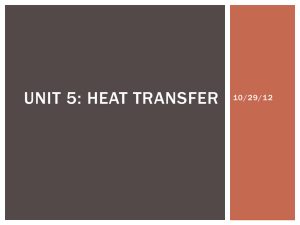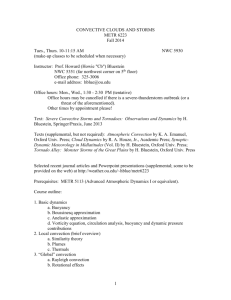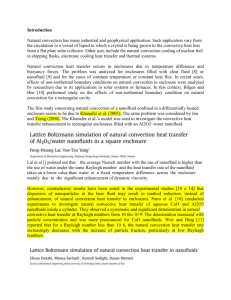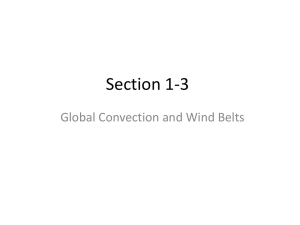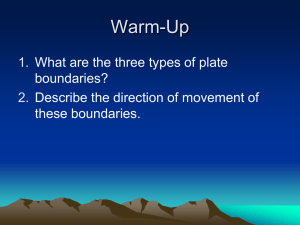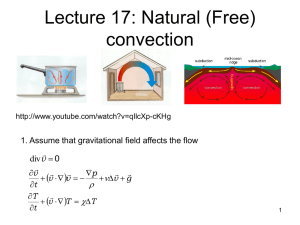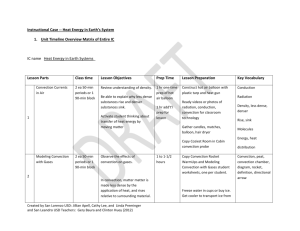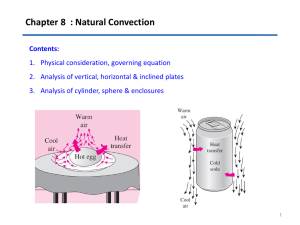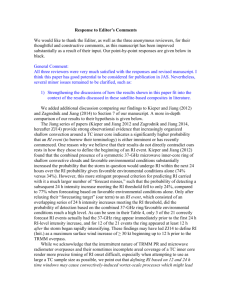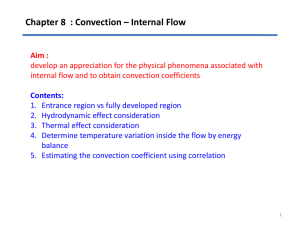Turbulent convection in the laboratory
advertisement
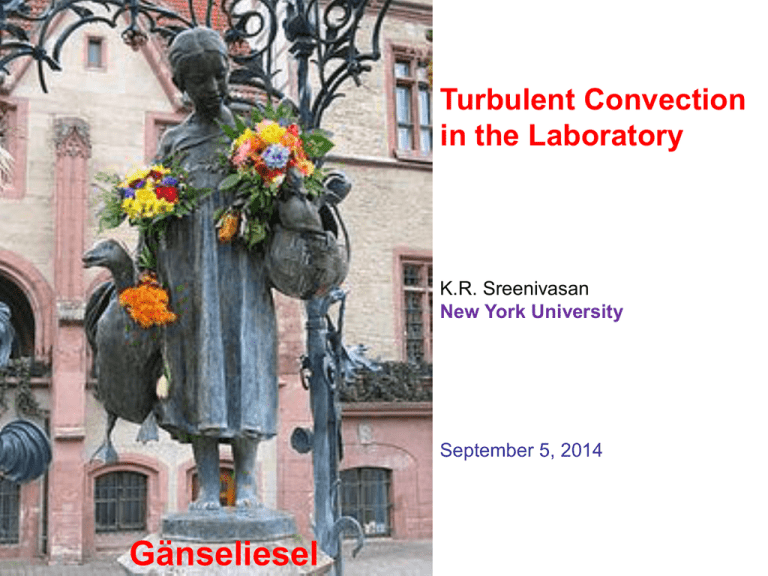
Turbulent Convection in the Laboratory K.R. Sreenivasan New York University September 5, 2014 Gänseliesel • Interior convection is an important ingredient of solar physics • I have been working on laboratory convection for many years • And have always thought controlled laboratory experiments might shed some light particularly on interior convection • Although you are all experts on the subject, I will explain some laboratory experiments and computer simulations which may have some bearing on your expertise. Basic Notation T Nu depends on… H Rayleigh number: Ra Fluid Prandtl number: Pr Aspect ratio: T+T D Nusselt number Nu = Q/(k T/H) gTH 3 D H S ~ detailed shape ?? Q = vertical heat flux k = thermal conductivity of the fluid (exponent close to 1/3) Niemela, Skrbek, KRS & Donnelly, Nature 404, 837 (2000) Slightly revised: Niemela & KRS, J. Low Temp. Phys. 143, 163 (2006) [Pioneers: Threlfall (Cambridge); Libchaber, Kadanoff and coworkers (Chicago)] Nu ≈ 2.61010 1010 Ra 108 gTH 3 Nu = Q/(k T/H) Plasting & Kerswell (2003) “upperbound” Nu ≈ 2.9109 Kraichnan (1962) “ultimate state” Nu ≈ 5106 (almost the same as the extrapolated value) 106 Seems consistent with Hanasoge, Duvall and KRS (2012) Convective processes are far from being optimally efficient. Ra=1024 Urban et al. (2014) See also: Roche et al. (2010) Chillá & Schumacher (2012) It is disappointing that we still don’t know with confidence the heat transport law at high Rayleigh numbers even in the simple case of Rayleigh-Bènard convection Data on Rotating Convection our data (from Cheng et al. (2014), modified by me) Sun 0.995 15 Nu/Nu0 15 4.23x10 <Ra<4.31x10 Nu(0) adjusted accodring to local slope 0.990 for calculating ratio Nu/Nucorr(0) 0.985 0.980 0.975 exponent: 0.024 0.970 log-log fit: 0.024 Nu=1.019Nucorr(0)Ro 0.965 0.960 0.4 0.5 0.6 0.7 0.8 0.9 1 2 convective Rossby number Rossby number Rotating Convection Heat transport decreases only modestly with rotation, and this appears true for the conditions of the Sun “Giant Convection Cells Found on the Sun”--title of a Science paper “Large-scale toroidal cells a challenge to theories of the Sun”---a website declares The mean wind The “mean wind” breaks symmetry, with its own consequences Large scale circulation (wind) largescale circulation (“mean wind”) the container For convection in a round cylinder, the mean wind precesses freely. For convection in a cubic box, the mean wind is constrained along a diagonal. The mean wind…with occasional reversals V(t), cm/s (KRS, Bershadskii & Niemela, PRE 65, 056306, 2000; Niemela et al. JFM, 2001) 10 VM Segment of continuous 120-hour record; 1 0 VM -10 0 2000 4000 6000 8000 10000 t, sec Geomagnetic polarity reversals Glatzmaier, Coe, Hongre & Roberts, Nature 401, 885-890 (1999) The reversals become more frequent with increasing Ra. J.J. Niemela and KRS J. Fluid Mech. 557, 411-422 (2006). 12.5 50 cm Ra = 1.9 x 109 4H12.5cm Aspect ratio effect Summary remarks High-Rayleigh-number convection experiments tantalize us with quantitative connections to the convection processes in the Sun: heat transport law, large-scale convection cells, rotation, etc. Alas, the connections seem to become weaker upon scrutiny, but there are reasons to be optimistic.
